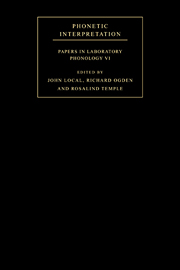Book contents
- Frontmatter
- Contents
- List of contributors
- Acknowledgements
- Introduction
- Part I Phonological representations and the lexicon
- 1 Interpreting ‘phonetic interpretation’ over the lexicon
- 2 Effects on word recognition of syllable-onset cues to syllable-coda voicing
- 3 Speech perception, well-formedness and the statistics of the lexicon
- 4 Factors of lexical competition in vowel articulation
- 5 Commentary: probability, detail and experience
- Part II Phonetic interpretation and phrasal structure
- Part III Phonetic interpretation and syllable structure
- Part IV Phonology and natural speech production: tasks, contrasts and explanations
- References
- Index of names
- Index of subjects
5 - Commentary: probability, detail and experience
Published online by Cambridge University Press: 22 September 2009
- Frontmatter
- Contents
- List of contributors
- Acknowledgements
- Introduction
- Part I Phonological representations and the lexicon
- 1 Interpreting ‘phonetic interpretation’ over the lexicon
- 2 Effects on word recognition of syllable-onset cues to syllable-coda voicing
- 3 Speech perception, well-formedness and the statistics of the lexicon
- 4 Factors of lexical competition in vowel articulation
- 5 Commentary: probability, detail and experience
- Part II Phonetic interpretation and phrasal structure
- Part III Phonetic interpretation and syllable structure
- Part IV Phonology and natural speech production: tasks, contrasts and explanations
- References
- Index of names
- Index of subjects
Summary
Introduction: word frequency and phonetic detail
The founding mothers of Laboratory Phonology have, on various occasions, been at pains to point out that Laboratory Phonology is not a theory of phonology, like say Autosegmental Phonology, but is rather a way of doing phonology that admits of a broad variety of different viewpoints, theories and ideas. For instance, Pierrehumbert, Beckman and Ladd (1996) suggest that ‘the existence of diverse views may perhaps serve to underscore one of our main points, which is that “laboratory phonology” is not a theoretical framework but rather a research community’. As the conference series has progressed, however, a fair number of important scientific results about phonology have been demonstrated, some of them several times over. To take one instance, at the fourth Laboratory Phonology meeting, Grabe and Warren (1995) and Vogel, Bunnell and Hoskins (1995) independently demonstrated that the Iambic Reversal analysis of the English Rhythm Rule (Liberman and Prince 1977: 319) is phonetically and perceptually untenable. To the extent that such results as these are at odds with mainstream generative phonology, it is becoming increasingly unrealistic to avoid numbering them as part of a coherent theoretical standpoint. Two such results are exhibited in the three papers I have been invited to comment on: in the mental storage and processing of phonological representations, a) phonetic detail matters, and b) word-frequency matters.
- Type
- Chapter
- Information
- Phonetic InterpretationPapers in Laboratory Phonology VI, pp. 88 - 100Publisher: Cambridge University PressPrint publication year: 2004



